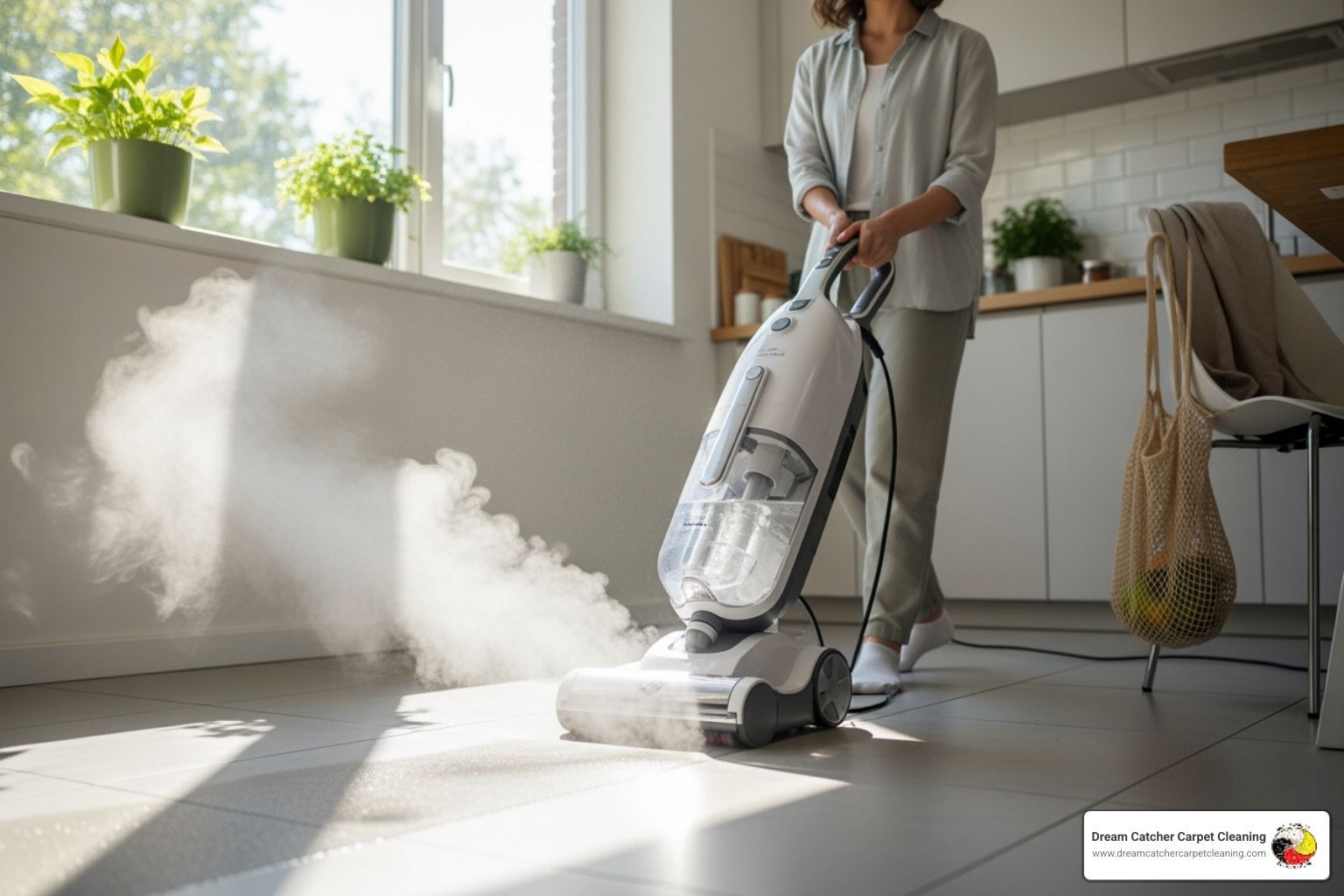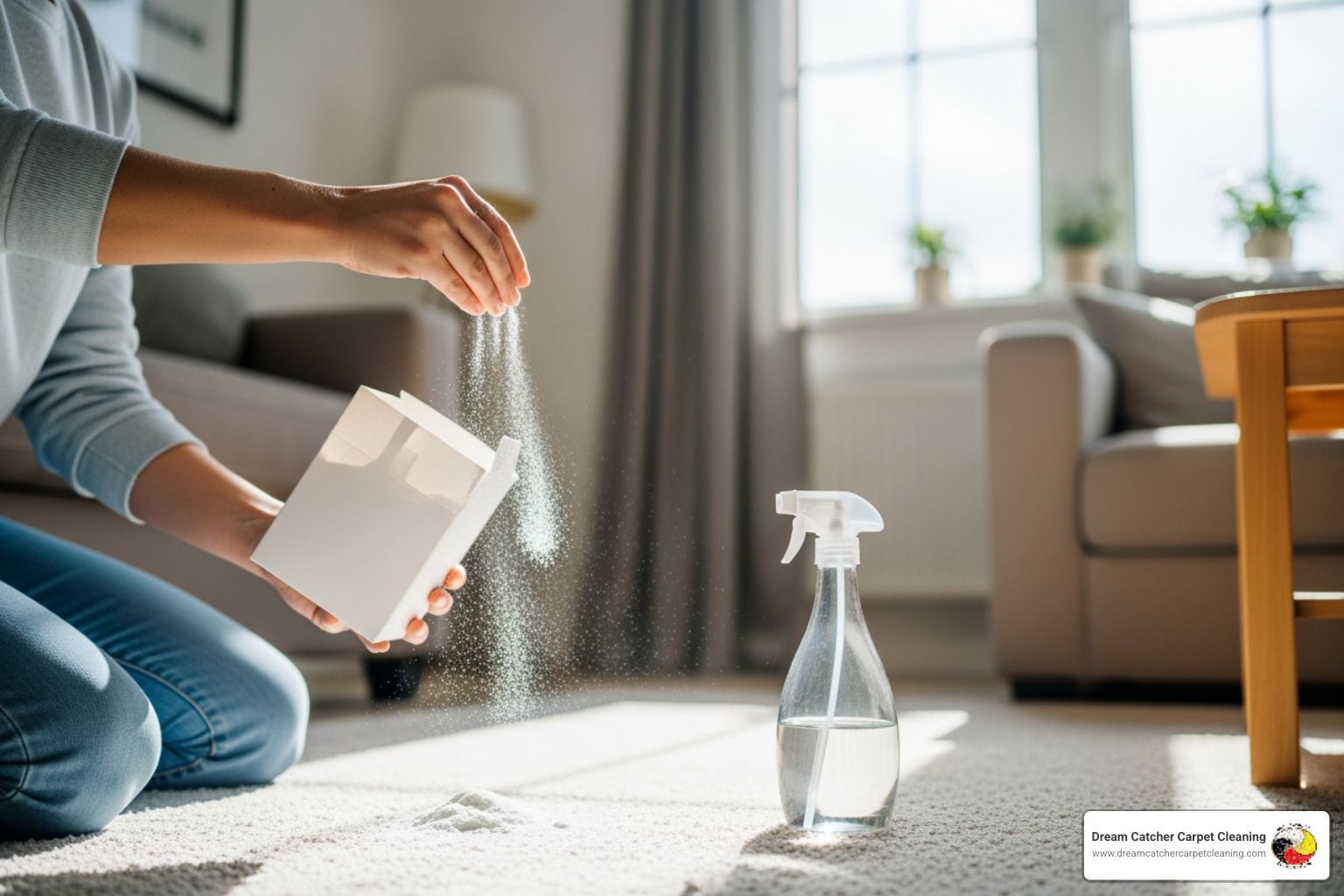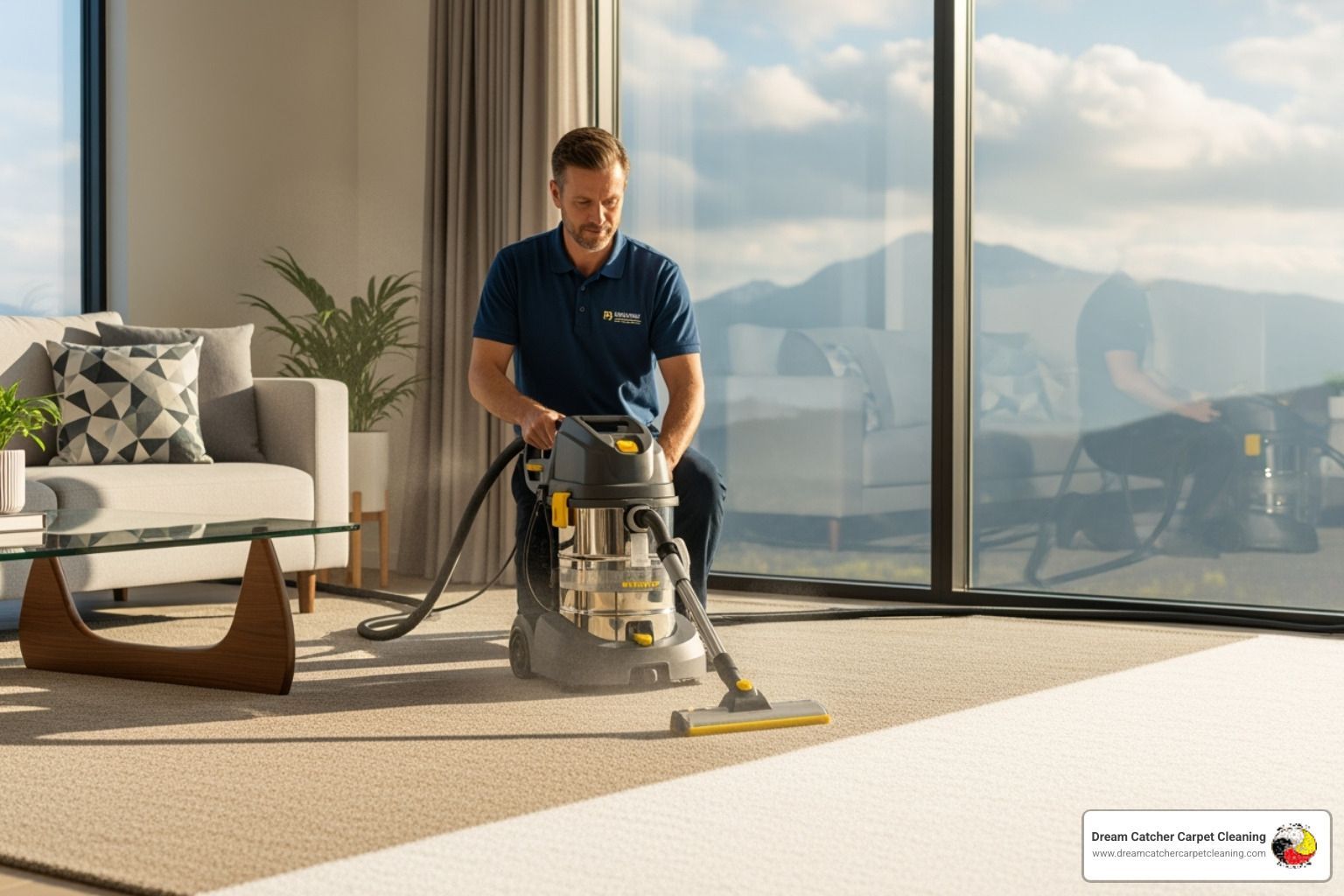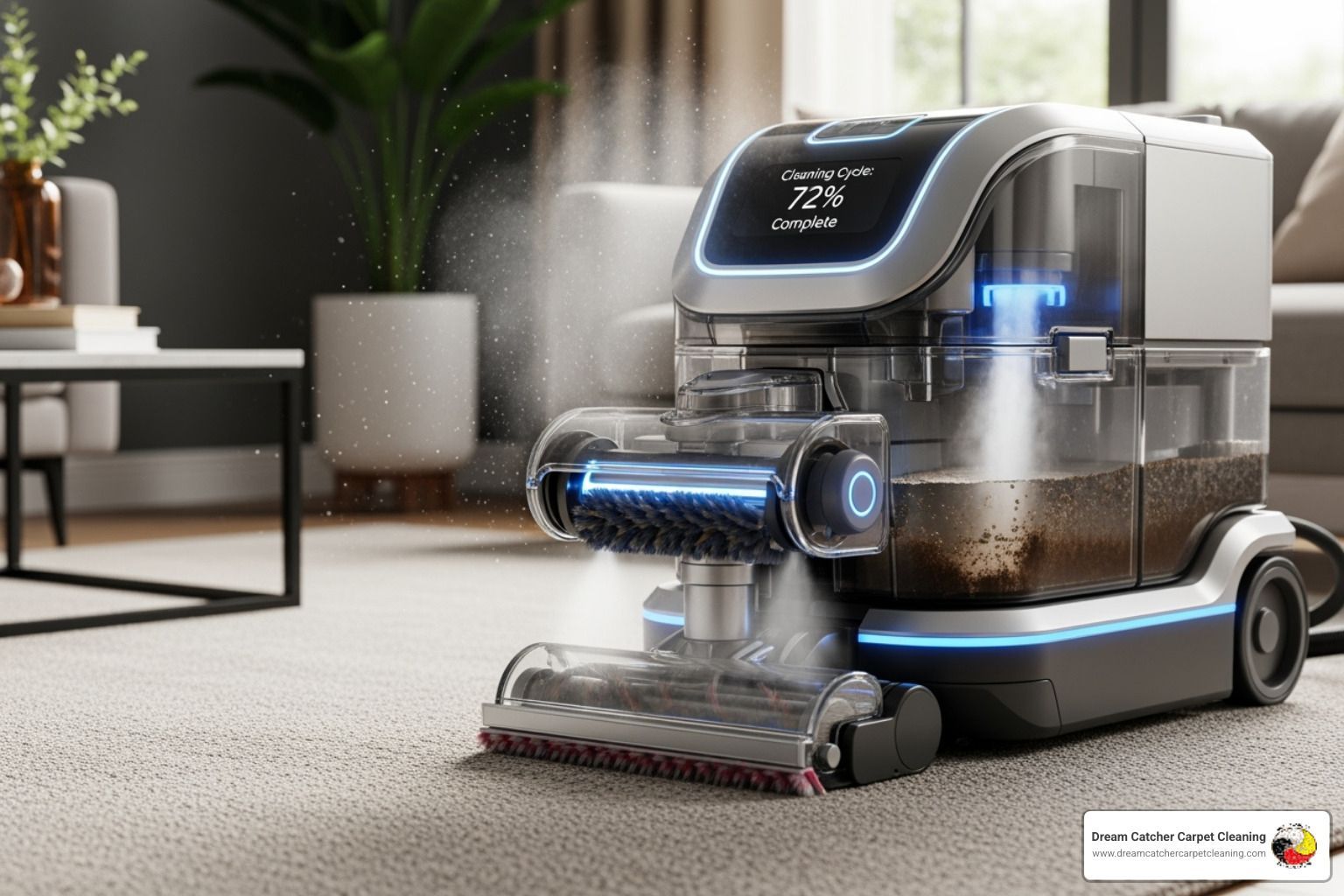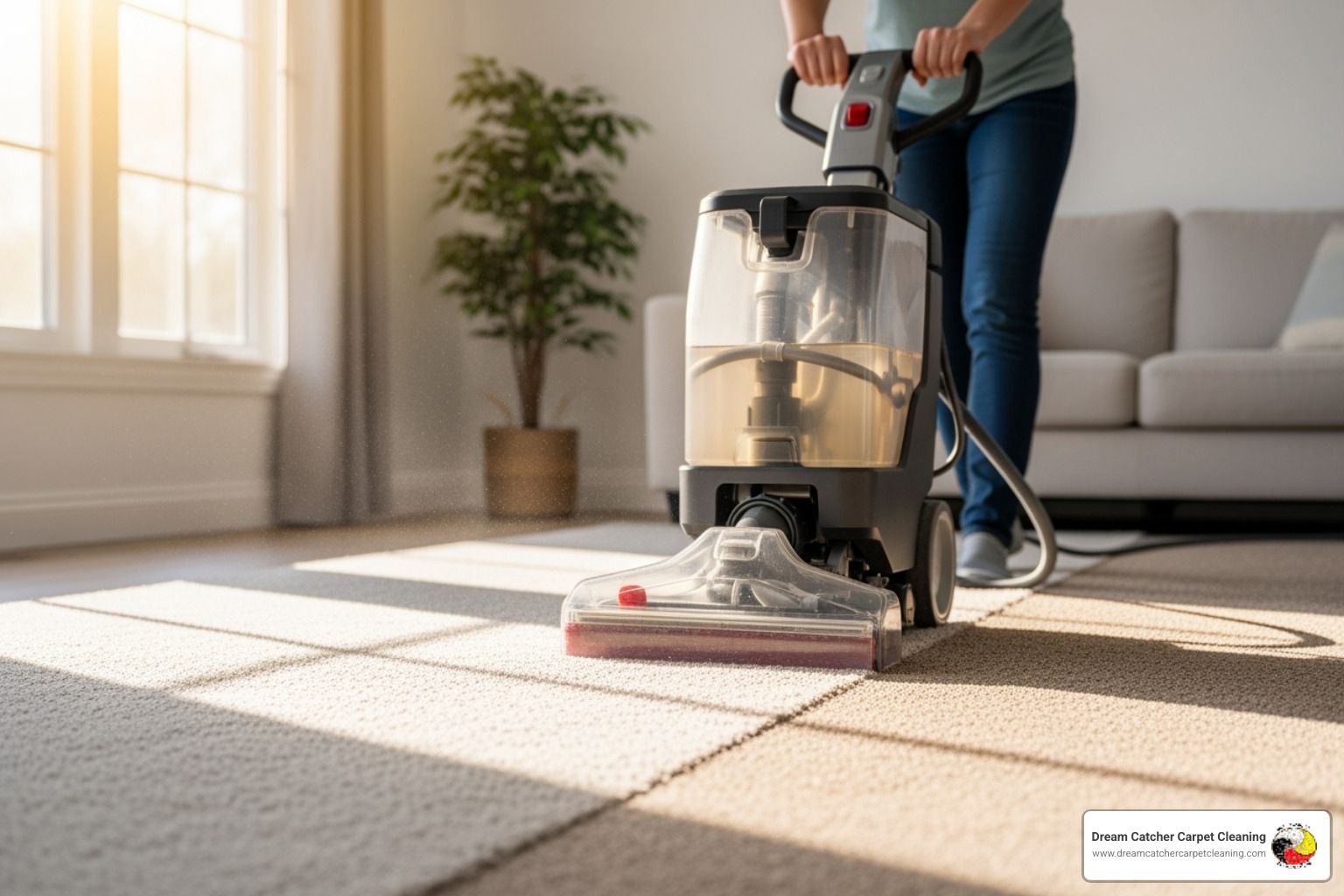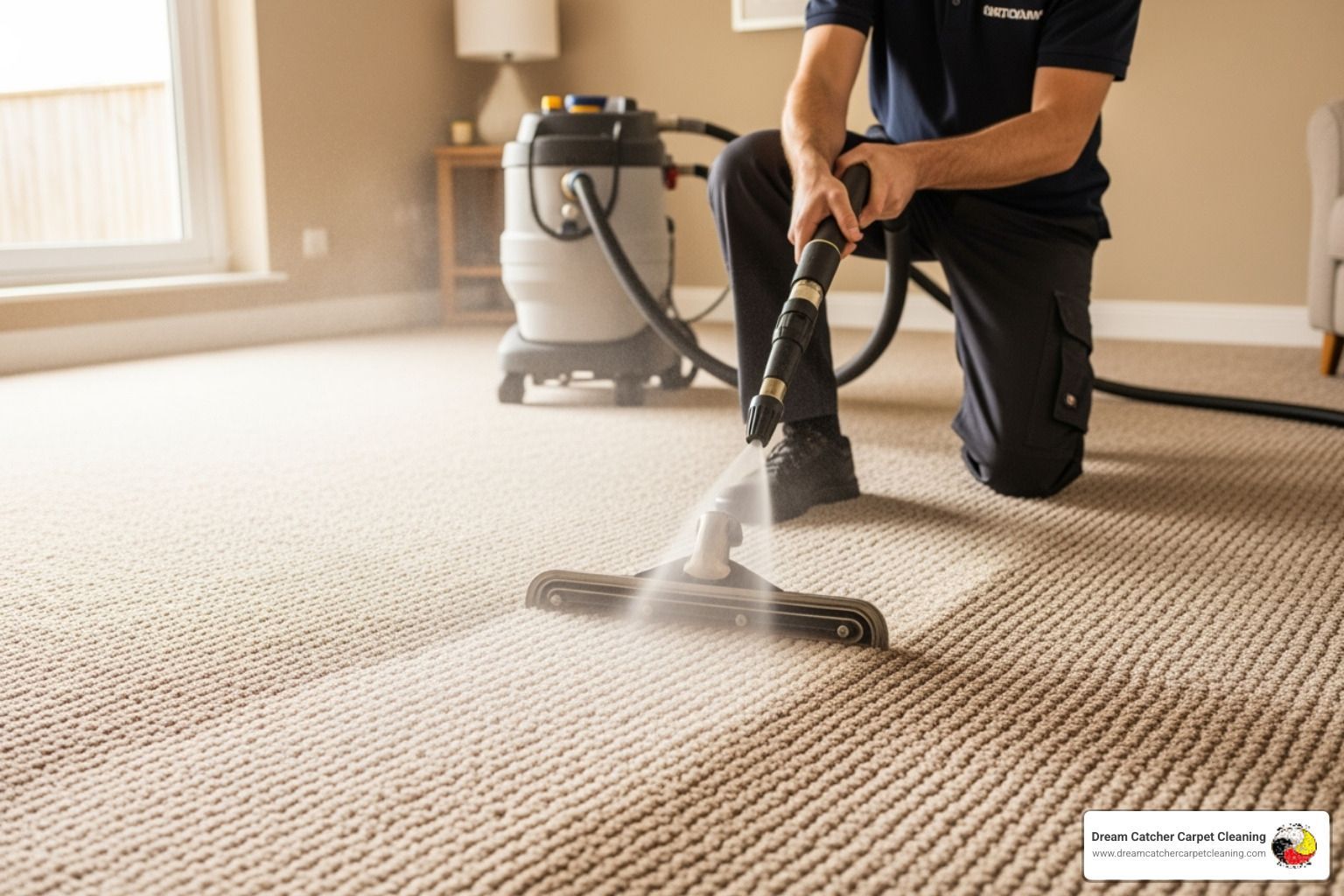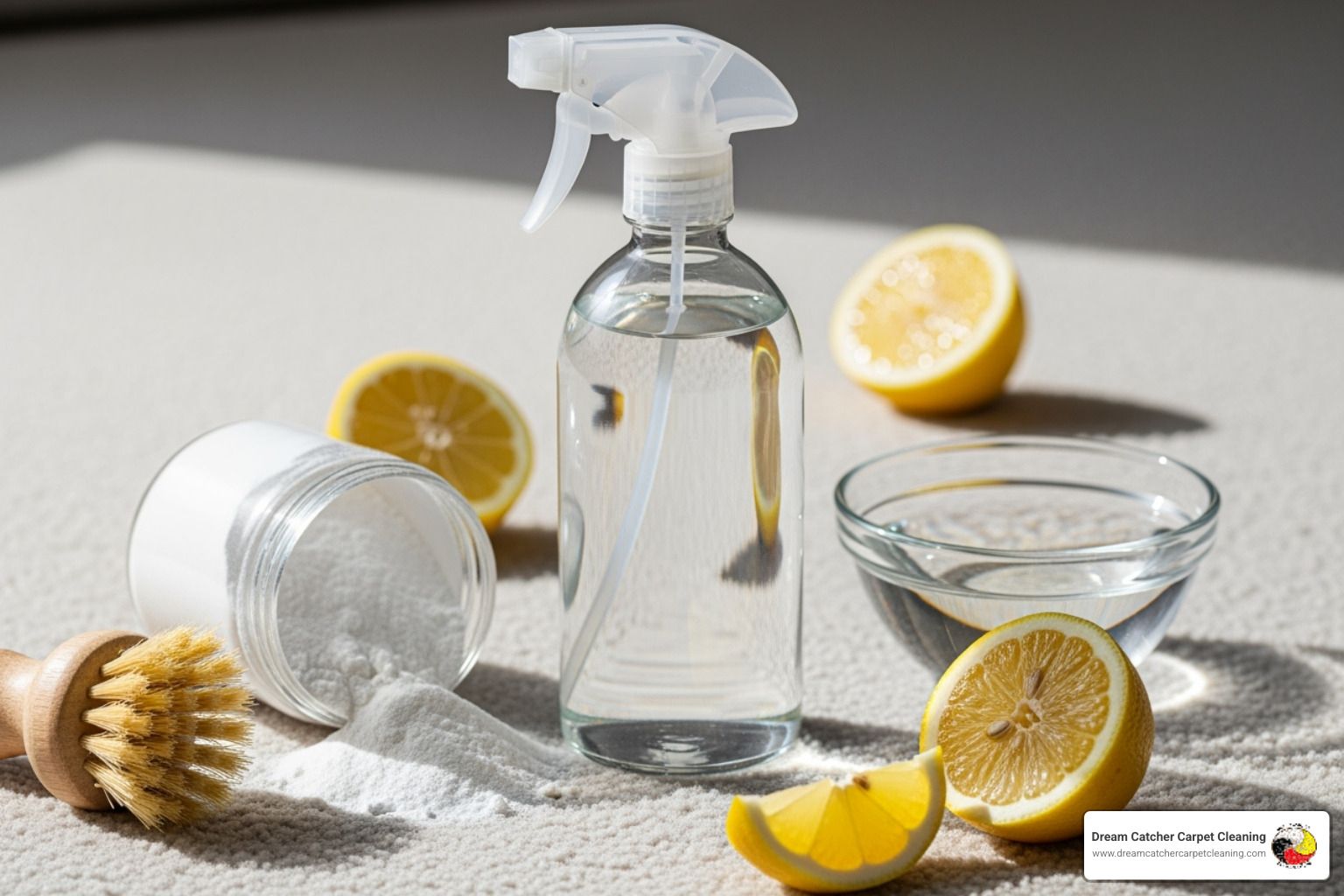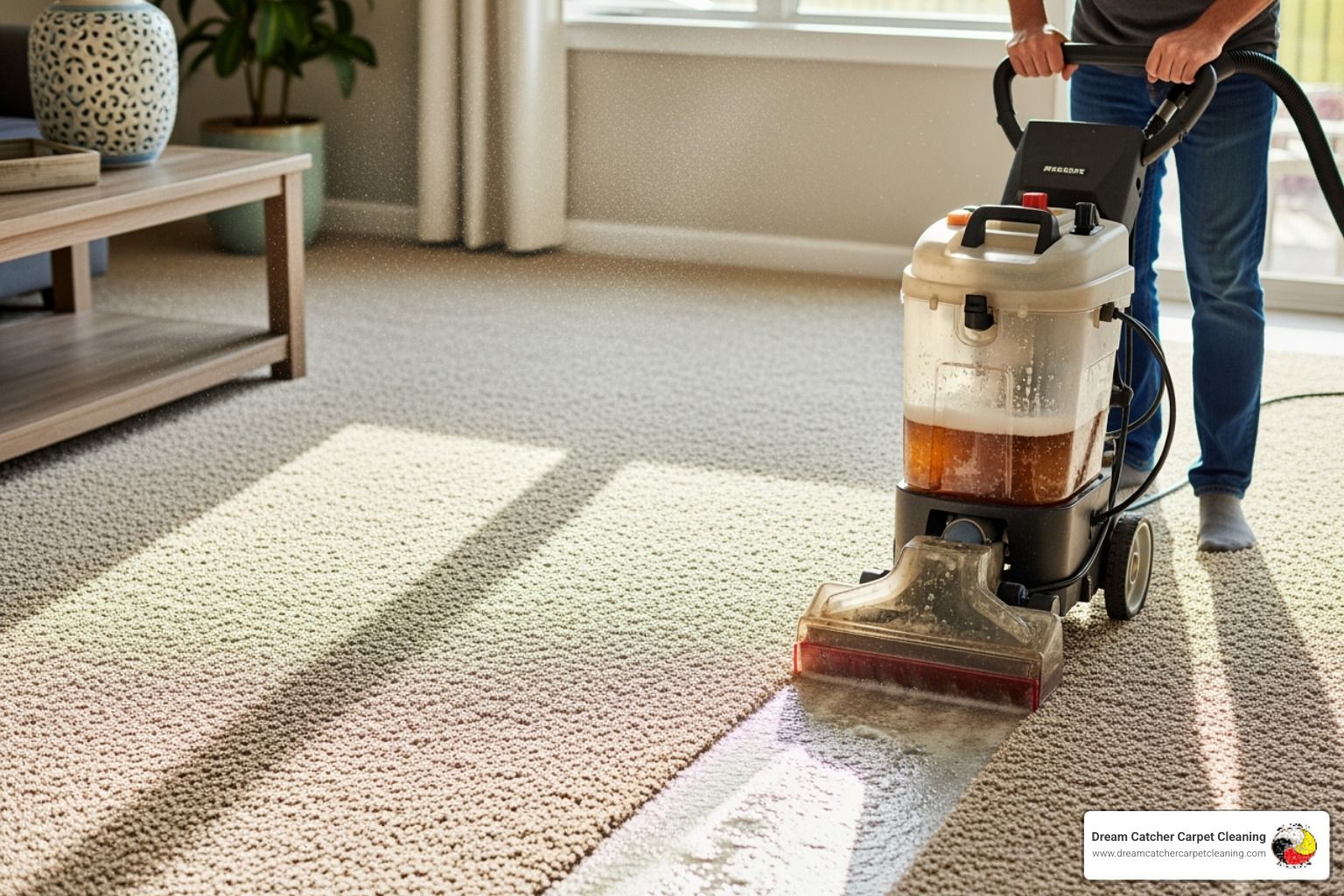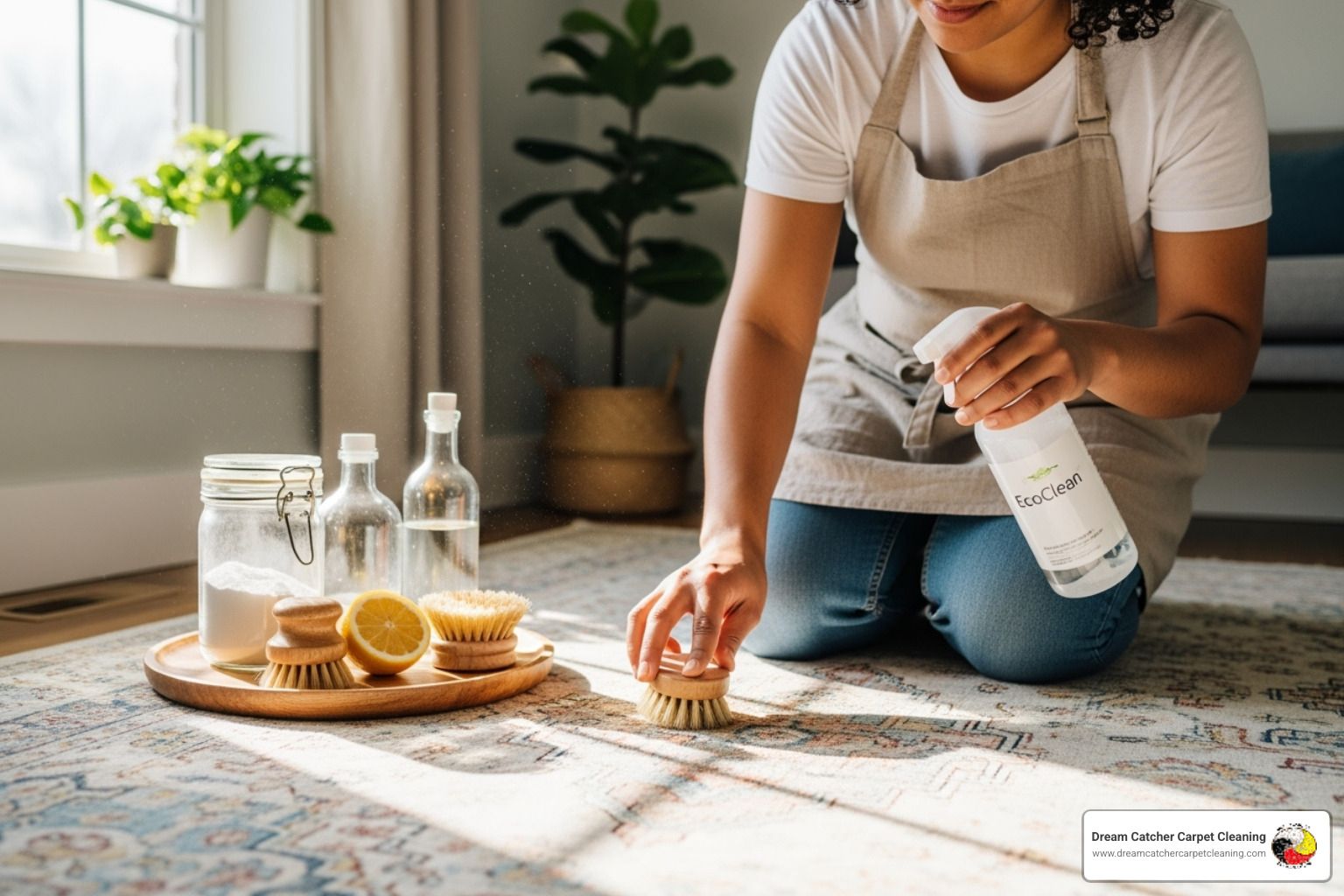Why Carpet Cleaning Stain Removal Doesn't Have to Be a Nightmare
Carpet cleaning stain removal can feel overwhelming when you're staring at a fresh spill on your favorite rug. But here's the good news: most stains come out easily when you know the right steps.
Quick Carpet Stain Removal Steps:
- Blot immediately - never rub or scrub
- Remove excess - scrape solids, absorb liquids
- Apply cleaner - work from outside edges inward
- Let it sit - 5-10 minutes for most solutions
- Rinse and blot - remove cleaning residue
- Dry completely - weight down towels overnight
Whether it's red wine from last night's dinner party, coffee from this morning's rush, or another pet accident, the key is acting fast and using the right technique. Research shows that enzymatic and oxygenated formulas clean tough stains more effectively than traditional methods, while simple household items like baking soda and hydrogen peroxide work wonders on fresh spills.
The biggest mistake most people make? Rubbing the stain deeper into the fibers instead of lifting it out. Don't worry - we've all been there.
I'm Clarence Smith, owner of Dream Catcher Carpet Cleaning with over 22 years of experience in carpet cleaning stain removal and IICRC certification since 2003. I've seen every type of stain imaginable, and I'm here to share the exact methods that work - without the stress or guesswork.
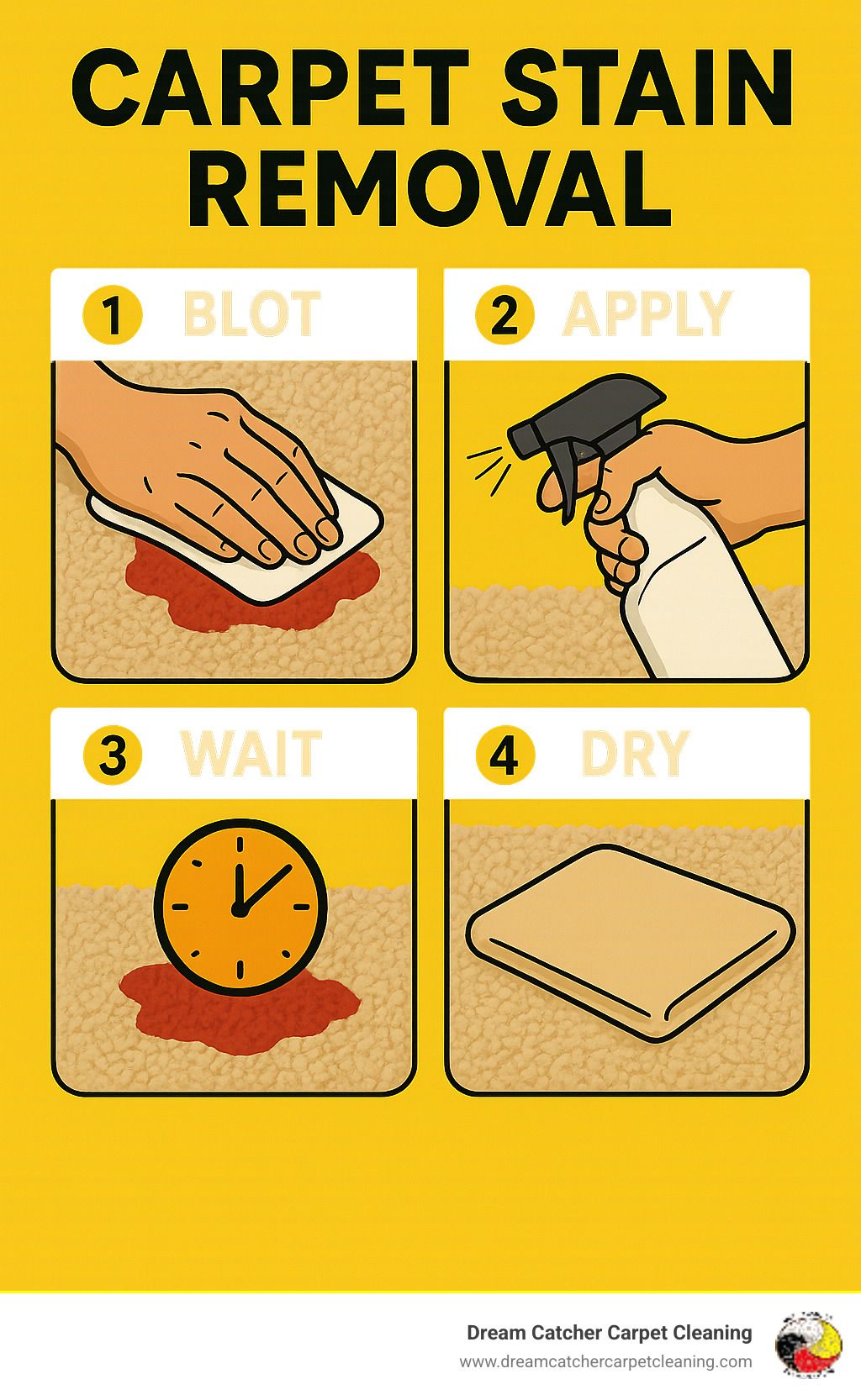
Understanding Carpet Stains: Types & Chemistry
Here's something that might surprise you: the biggest reason carpet cleaning stain removal fails isn't because people don't try hard enough - it's because they're using the wrong approach for their specific type of stain. After two decades of cleaning carpets in the North Metro Denver area, I've learned that understanding what you're dealing with is half the battle won.
Think of stains like different personalities. Water-soluble stains from juice, soda, and most beverages are the easy-going types - they respond well to simple water and mild dish soap. They want to dissolve and disappear without much fuss.
Protein-based stains from blood, pet accidents, and dairy spills are the stubborn ones. They need special treatment with cold water (never hot - that'll cook the proteins right into your carpet) and enzyme cleaners that literally eat away the organic compounds.
Oil and grease stains are the slippery characters that repel water-based cleaners. They need surfactants to break their grip on carpet fibers. Meanwhile, tannin stains from coffee, tea, and red wine are the dramatic ones - they love to make a statement and often need oxidizing agents to break apart their color molecules.
Your carpet type matters too. Wool carpets are like delicate flowers - beautiful but sensitive to harsh chemicals and heat. Nylon and polyester are the workhorses that can handle more aggressive cleaning, but even they have their limits with bleach-based products.
Here's the timeline that makes or breaks your success: fresh spills give you a golden window of about 10 minutes before they start bonding with carpet fibers. After 24 hours, you're dealing with a set-in stain that requires more advanced techniques.
Why Different Stains React Differently
Let me share some simple chemistry that'll make you a stain-fighting superhero. Hydrogen peroxide works through oxidation - imagine it as tiny bubbles that break apart the molecular chains creating those stubborn colors. That's why it's amazing on blood and wine stains, literally erasing them at the molecular level.
Enzymes are nature's cleanup crew. These biological helpers specifically target organic compounds, which is why they're incredible for pet stains. They don't just cover up odors - they actually digest the bacteria and proteins causing them. This is why enzyme cleaners need time to work their magic, usually 15 minutes or more.
Surfactants in dish soap act like molecular matchmakers, helping water and oil become friends. They reduce surface tension so water can penetrate and lift greasy stains that would normally laugh at water-based cleaners.
Understanding pH basics helps too. Most household stains are acidic, which is why alkaline solutions like baking soda work so well as neutralizers.
Testing for Colorfastness Before You Start
Before you dive into any carpet cleaning stain removal project, do yourself a favor and test in a hidden corner - maybe under the couch or behind a door. Apply a small amount of your cleaning solution and blot with a white cloth. If you see any carpet color transferring to the cloth, stop immediately and try something gentler.
For hydrogen peroxide specifically, start with the standard 3% solution you find at drugstores, but test it first. Scientific research on hydrogen peroxide safety confirms it's generally safe for household use, but some carpets can bleach or discolor.
The white cloth test is crucial - colored towels can actually transfer dye to your carpet, creating a whole new problem you didn't have before. Cold water is always safer than warm for initial testing, especially on wool or vintage carpets.
Trust me, spending two minutes on this test can save you from turning a small stain into a big bleach spot.
The Complete Process of Carpet Cleaning Stain Removal

This is paragraph text. Click it or hit the Manage Text button to change the font, color, size, format, and more. To set up site-wide paragraph and title styles, go to Site Theme.
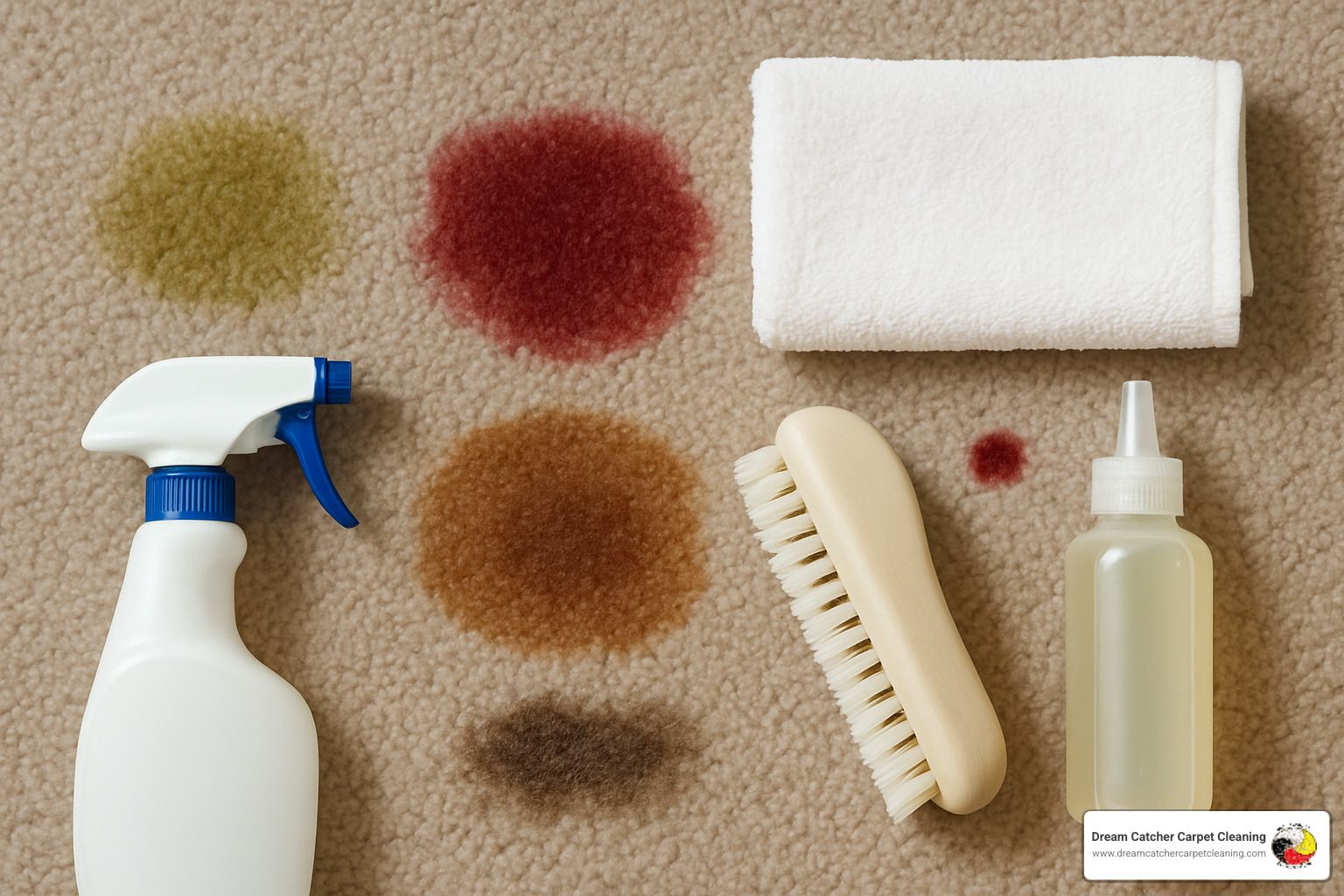
Here's where carpet cleaning stain removal gets interesting. After 22 years of tackling everything from red wine disasters to mysterious sticky spots, I've learned that each type of stain has its own personality - and its own kryptonite.
The biggest mistake I see homeowners make is treating all stains the same way. Your approach to pet accidents should be completely different from how you handle that glass of wine that got knocked over during last night's dinner party. Let me walk you through the specific techniques that actually work for the toughest stains we encounter here in the North Metro Denver area.
Pet Stains & Odors: Enzyme Power
Pet accidents are the ultimate test of any carpet cleaning stain removal method. They're sneaky because what you see on the surface is only part of the problem - the real challenge is the odor-causing bacteria hiding deep in your carpet padding.
The first rule? Always use cold water initially. Hot water will cook the proteins in urine and make the stain permanent. Trust me, I've seen too many well-meaning pet owners accidentally make their problem much worse by reaching for warm water.
Start by blotting up as much liquid as possible, then apply your enzyme cleaner generously. Here's the key part that most people skip: let it sit for a full 15 minutes. Enzymes are living organisms that need time to digest the organic compounds causing the odor. Think of them as tiny Pac-Men eating up the source of your problem.
After the enzyme treatment, blot thoroughly and rinse with cold water. If you still detect odor after it dries, don't give up - apply a second enzyme treatment. Sometimes stubborn stains need a double dose. A black light can reveal any spots you might have missed, since pet urine glows under UV light.
For particularly challenging pet stain situations, we've developed specialized techniques that go beyond what's possible with store-bought products. You can learn more about our effective solutions for stubborn pet stains and odors.
Dark Drinks: Red Wine & Coffee
Red wine spills are legendary for striking fear into homeowners' hearts, but honestly? They're not as scary as their reputation suggests. The secret weapon that surprises everyone is white wine as a neutralizer. It sounds crazy, but the alcohol in white wine actually dilutes the tannins in red wine that cause the staining.
If you don't have white wine handy (or you're not willing to sacrifice a good bottle), cold water works too. Blot up the excess immediately, then mix hydrogen peroxide with dish soap in a 2:1 ratio. Apply this solution and let it work for about 10 minutes - you'll often see the stain literally disappear before your eyes.
Coffee and tea stains follow similar rules, but they're even more time-sensitive because the heat makes them set faster. The same hydrogen peroxide and dish soap combination works wonders, followed by thorough rinsing and weighted towels overnight to draw out all the moisture.
Protein Spills: Blood & Dairy
Here's where things get scientific. Never, ever use hot water on protein stains - it will cook the proteins and turn your manageable stain into a permanent reminder of that kitchen accident.
For blood stains, ice-cold water is your best friend. If plain water isn't cutting it, try a saline solution first - just one tablespoon of salt in a cup of cold water. The salt naturally breaks down proteins without harsh chemicals.
When saline isn't enough, hydrogen peroxide is incredibly effective on blood, but always test it in a hidden corner first. Some carpets can be sensitive to peroxide, and it's better to find that on a patch under your couch than in the middle of your living room.
Milk spills and other dairy accidents need immediate attention with cold water, followed by an enzyme cleaner. The proteins in dairy can create some seriously unpleasant sour odors if they're not broken down properly.
Grease, Oil & Wax
Grease and oil stains play by different rules because they hate water. Your usual water-based solutions will just roll right off, which is why baking soda is your secret weapon here.
Sprinkle baking soda generously over fresh grease stains and walk away. Let it sit for several hours - overnight is even better. The baking soda acts like a sponge, pulling the oil up from deep in your carpet fibers. When you vacuum it up, you'll be amazed at how much grease comes with it.
For any stubborn residue, a tiny amount of dish soap mixed with warm water will handle what the baking soda missed. Just remember to rinse thoroughly afterward.
Wax removal is actually easier than most people think, though it looks intimidating. Grab a brown paper bag or paper towel, place it over the wax, and run a warm iron over it. The heat melts the wax, and the paper absorbs it like magic. You might need to use fresh paper and repeat the process a couple times, but it works every time.
For more detailed information about our professional cleaning methods and when it might be time to call in reinforcements, check out our comprehensive carpet cleaning services.
Preventing Future Stains & Long-Term Carpet Care
Here's what I've learned after 22 years in the carpet cleaning stain removal business: the families with the cleanest carpets aren't necessarily the most careful - they're the smartest about prevention. Small daily habits make a huge difference in keeping your carpets looking fresh and extending their life.
Think about it this way - every time you prevent a stain, you're saving yourself the time, stress, and cost of dealing with it later. Plus, carpets that are well-maintained actually resist staining better over time.
Daily & Weekly Habits that Extend Carpet Life
The single most effective change you can make? Implement a no-shoes rule. I know it sounds dramatic, but shoes are like tiny dirt delivery systems. They track in soil, road salt, chemicals from parking lots, and who knows what else. All of that grime gradually breaks down carpet fibers and creates a breeding ground for stains.
Quality door mats are your second line of defense. Place them both inside and outside every entrance, and actually clean them regularly. A dirty mat just redistributes the problem instead of solving it. We've seen homes where replacing cheap mats with high-quality ones made a visible difference within weeks.
Your vacuum patterns matter more than you might think. Going in the same direction every time creates uneven wear patterns that make your carpet look older faster. Switch it up weekly - north to south one week, east to west the next. For high-traffic areas like hallways and entryways, consider placing attractive area rugs that can be easily cleaned or replaced.
The most important habit of all? Keep a spray bottle of your preferred cleaning solution ready in a convenient spot. The difference between a five-minute cleanup and a permanent stain often comes down to those first crucial moments after a spill happens.
When to Apply Protectants or Sealers
Carpet protectants work like an invisible shield around each fiber, giving spills time to bead up on the surface instead of immediately soaking in. Professional protectant treatments typically last 12-18 months and can be the difference between an easy cleanup and a permanent stain.
The math is pretty compelling when you think about it. A professional protectant treatment costs a small fraction of carpet replacement, yet it can prevent thousands of dollars in damage from everyday accidents. We've seen families with young kids or pets whose carpets still look amazing after years, simply because they invested in quality protection.
Scotch-guard style protectants are particularly effective on natural fibers like wool, which are more vulnerable to staining. Even synthetic carpets benefit significantly from protection, especially in high-traffic areas or homes with frequent entertaining.
The best time to apply protectants is right after a professional cleaning when your carpet is completely clean and dry. This ensures maximum penetration and effectiveness. For more detailed information about maintaining your carpet between professional cleanings, check out our guide on what is the best way to clean a carpet.
Frequently Asked Questions about Carpet Cleaning Stain Removal
How soon should I treat a spill?
Time is absolutely everything when it comes to carpet cleaning stain removal. I tell all my clients in Thornton and the surrounding Denver area: if you can get to a spill within the first few minutes, you're golden.
Here's what happens scientifically - most stains start bonding with your carpet fibers within 10-15 minutes of contact. Fresh wine might look scary spreading across your beige carpet, but it's actually just sitting on the surface. Wait an hour, and those tannins have worked their way deep into the fiber structure.
Act within minutes if possible - this single factor determines whether you'll need a simple blot-and-clean or a full professional treatment. I've seen identical red wine spills where one homeowner cleaned it immediately with just cold water and paper towels, while another waited until the next morning and needed our full enzyme treatment process.
Are plant-based cleaners as effective as chemicals?
This is one of my favorite questions because the answer might surprise you. Enzyme-based cleaners are often more effective than traditional chemicals on organic stains - and yes, most enzymes come from plant sources.
Here's the difference: chemical cleaners try to lift stains up and out. Enzymes actually digest the stain at a molecular level. They're like tiny Pac-Men eating the proteins and bacteria that cause both staining and odors. That's why we use eco-friendly enzyme treatments for most of our pet stain work.
The trade-off? Plant-based cleaners need more patience. While chemical spotters work in 5-10 minutes, enzymes typically need 15-20 minutes to do their magic. But the results are often superior, especially for protein-based stains like blood, urine, or food spills.
As an eco-friendly company, we've found that plant-based solutions are not only safer for your family and pets, but they often outperform harsh chemicals on the toughest stains.
When do I need professional help?
After 22 years in the business, I can usually tell within the first minute of a phone call whether a homeowner can handle a stain themselves or needs our help. Don't feel bad about calling professionals - some situations are just beyond what household products can handle.
Call us when DIY methods have failed after 2-3 honest attempts. If you've tried multiple solutions and the stain keeps coming back, you're likely dealing with something that's penetrated into the carpet backing or pad underneath.
Size matters too - anything larger than a dinner plate usually needs professional equipment. Our truck-mounted extractors can pull stains from deep in the carpet that no amount of home blotting can reach.
Set-in stains over 24 hours old are another red flag. Once stains have had time to cure and bond with the fibers, they often need specialized treatments and professional-grade solutions that aren't available to consumers.
And here's something many people don't consider: if you're dealing with expensive carpet, the cost of professional cleaning is tiny compared to replacement. I've seen too many homeowners accidentally bleach or damage beautiful wool carpets trying to save a few dollars on professional treatment.
Bodily fluids, pet accidents that keep returning, or anything involving potential health hazards should always be handled professionally. We have the proper equipment and training to sanitize these situations safely.
Conclusion & When to Call the Pros
Carpet cleaning stain removal doesn't have to be stressful when you have the right knowledge and tools. Remember the key principles: act fast, blot don't rub, work from outside edges inward, and always test cleaning solutions first.
For most fresh spills, simple household items like baking soda, vinegar, and hydrogen peroxide will do the job beautifully. When stains are stubborn, set-in, or cover large areas, that's when professional intervention makes sense.
At Dream Catcher Carpet Cleaning, we've been helping families in Thornton and throughout the North Metro Denver area maintain beautiful carpets for over two decades. Our eco-friendly approach protects your family while delivering superior results. We use advanced equipment and specialized techniques that can rescue carpets that seem beyond hope.
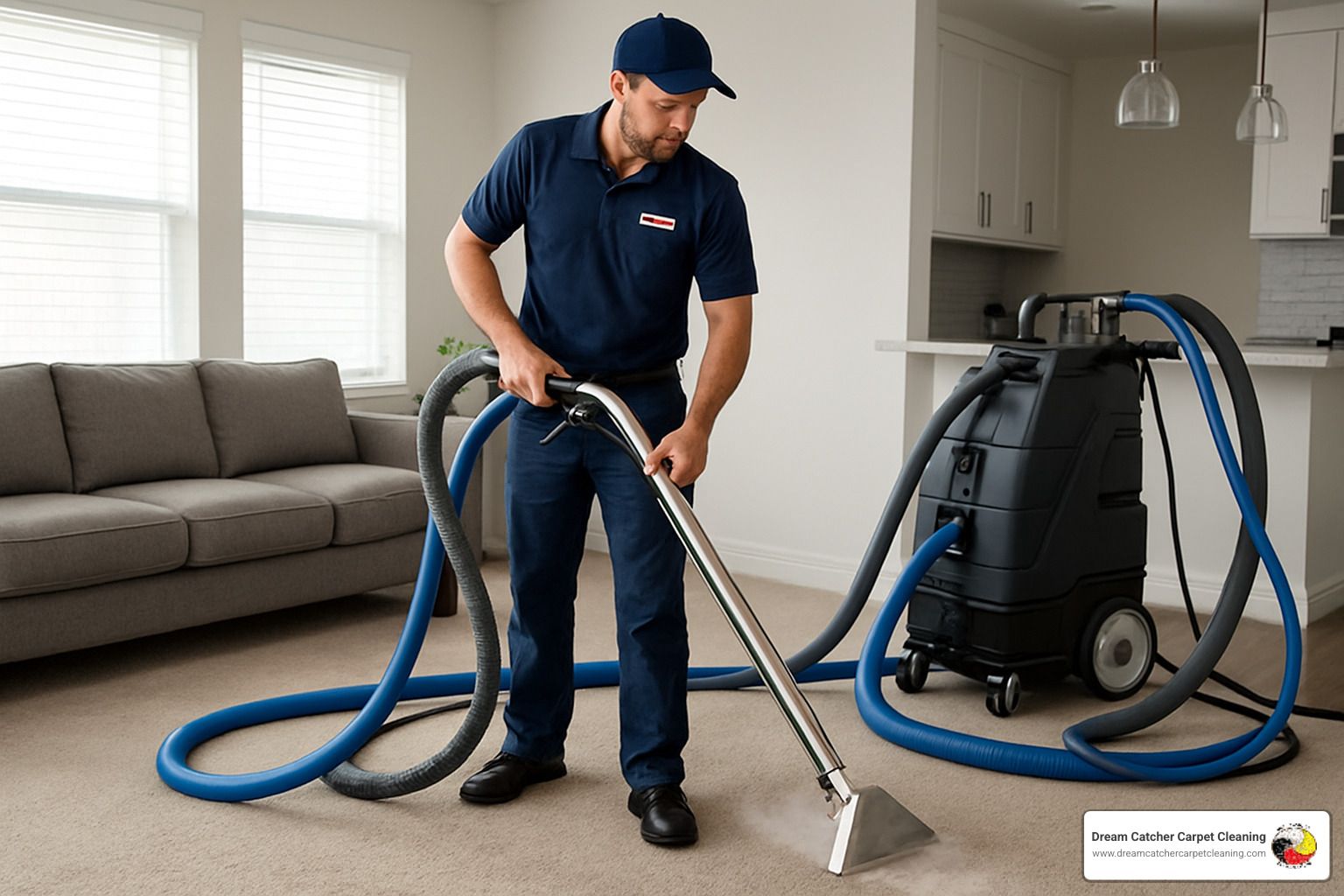
The peace of mind that comes from knowing your carpets are truly clean and healthy is invaluable. Whether you need emergency stain removal or regular maintenance cleaning, we're here to help you keep your home looking and feeling its best.
Ready for a deeper clean? Learn more about our comprehensive carpet steam cleaning services and find why families throughout Boulder, Fort Collins, Westminster, and beyond trust us with their most challenging carpet care needs.

